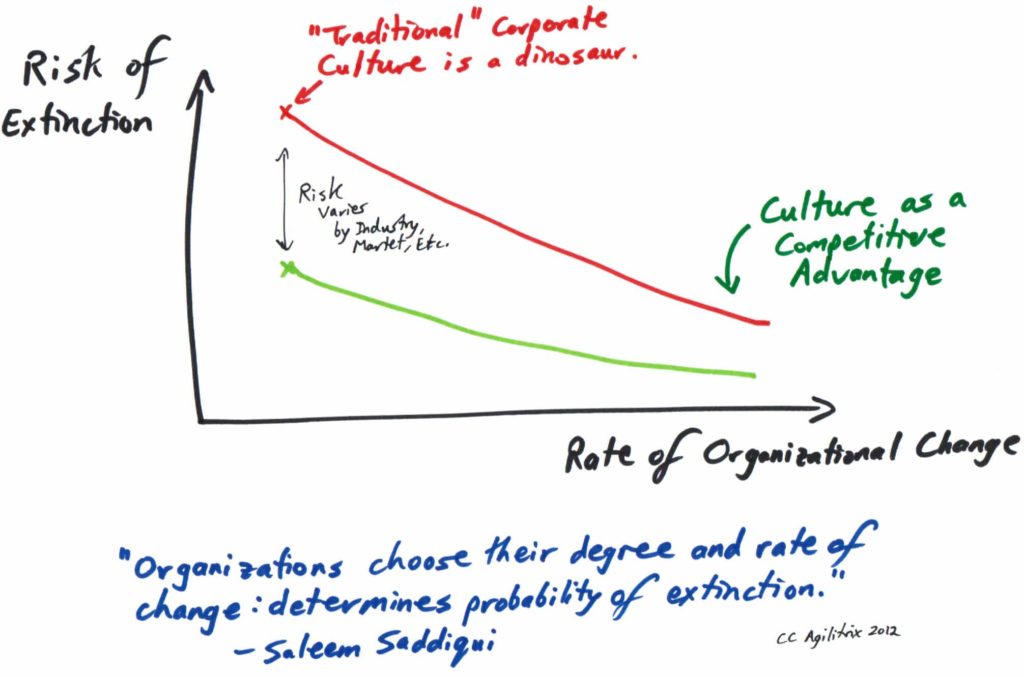Great Organizational Culture is Key to Thriving
Deming said that “Survival is Optional”. Organizations can change their mindset and culture or they can become extinct.
Companies are at Risk
Steven Denning makes a great case for why companies are at risk: Only 21% of employees are fully engaged, Customers are dis-satisfied and bureaucracy is killing innovation. “Deloitte’s Shift Index shows, the average life expectancy of a Fortune 500 company has declined from around 75 years half a century ago to less than 15 years today, and heading towards 5 years if nothing is done.” We can see new companies creating opportunity by using organizational culture as the competitive advantage. Some examples are: Zappos, Morningstar, Valve.
Choose your Level of Risk
 The graph above shows that the risk of extinction for an organization depends on the rate or ability of the organization to change. As discussed about, traditional corporate culture poses a high level of risk as it only tolerates a low rate of change. Organizations that use culture as a competitive advance have a lower risk of extinction. The two lines show that different organizations have differing risk profiles based on industry and markets they are involved in. We can think of a fitness landscape of organizations: some are very robust to environmental changes and others are brittle. The top reason to change the culture of your organization is not because of this quarter, this financial year, but to create a lasting future and avoid the extinction event that is perhaps a few years out. Sadly, few companies invest time into thinking about how can we be great and how can we go out of business – the status quo is a powerful attractor.
The graph above shows that the risk of extinction for an organization depends on the rate or ability of the organization to change. As discussed about, traditional corporate culture poses a high level of risk as it only tolerates a low rate of change. Organizations that use culture as a competitive advance have a lower risk of extinction. The two lines show that different organizations have differing risk profiles based on industry and markets they are involved in. We can think of a fitness landscape of organizations: some are very robust to environmental changes and others are brittle. The top reason to change the culture of your organization is not because of this quarter, this financial year, but to create a lasting future and avoid the extinction event that is perhaps a few years out. Sadly, few companies invest time into thinking about how can we be great and how can we go out of business – the status quo is a powerful attractor.
What Culture?
OK, let’s say I want to change my culture. Now what? There are a number of related and complementary approaches. Stephen Denning argue that the single organizational focus needs to be Customer Delight. Senge advocates the need for a Learning Organization. The Agile mindset is about people with a shared vision collaborating and learning together. A key misunderstood value from Lean is Respect for People. There are also recent movements and ideas converging on what thriving organizations look like: Stoos Network, WorldBlu and Future of Work Manifesto. What is best? Many are good and share common characteristics. My current investigation is to clarify and refine cultural differences between various approaches. The most important thing to remember is that: Perfection is a direction and not a target. Use KrisMap or another approach to define your ideal culture and then pursue it.
Acknowledgements
This post is inspired by conversations and a session with Saleem Saddiqui at Agile Coach Camp in Minneapolis earlier this month. It was Saleem who shared the quote “Survival is Optional” to start a great conversation. Key ideas in this post are Saleem’s – not sure what he shared and what I imagined.


